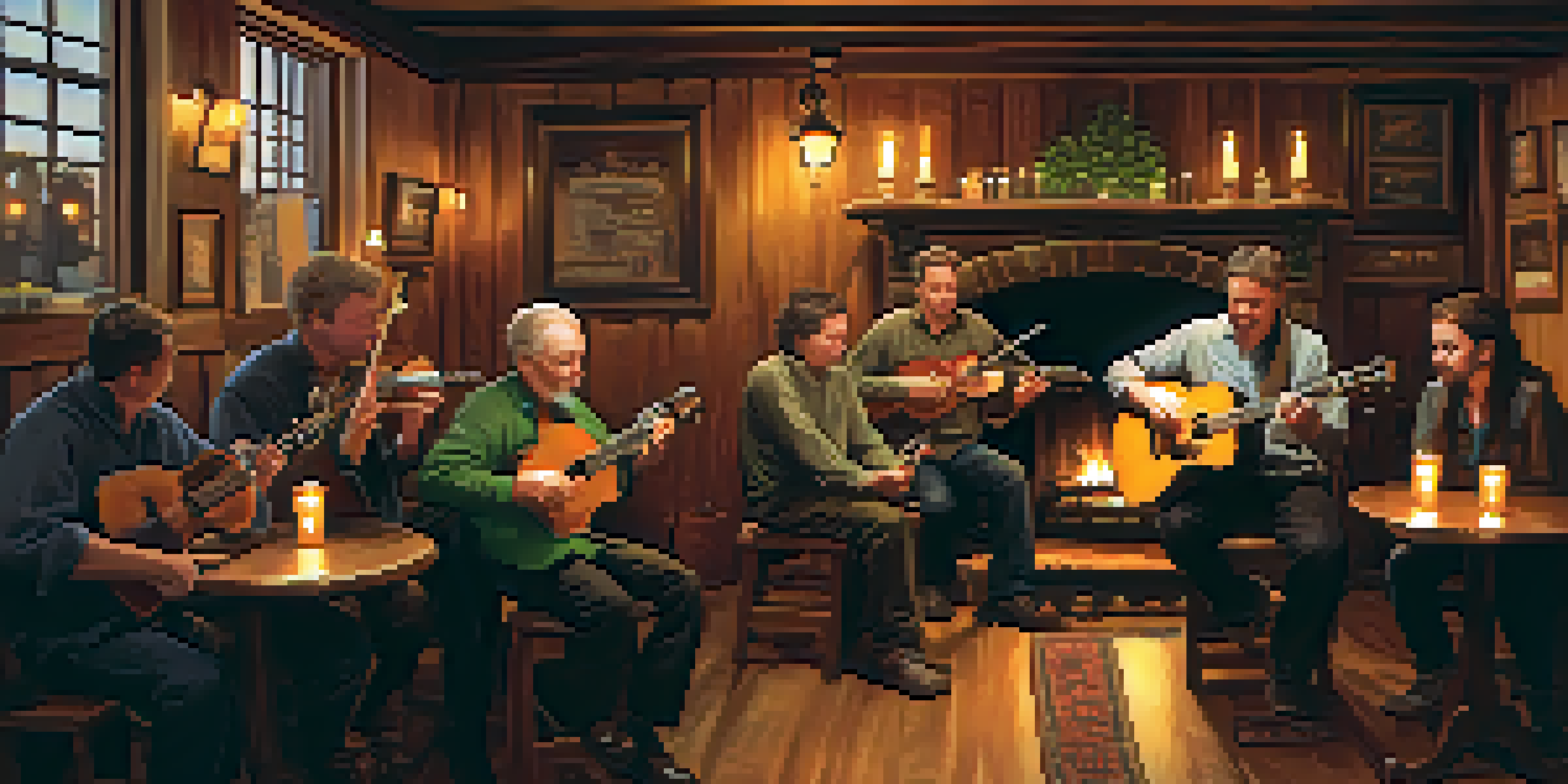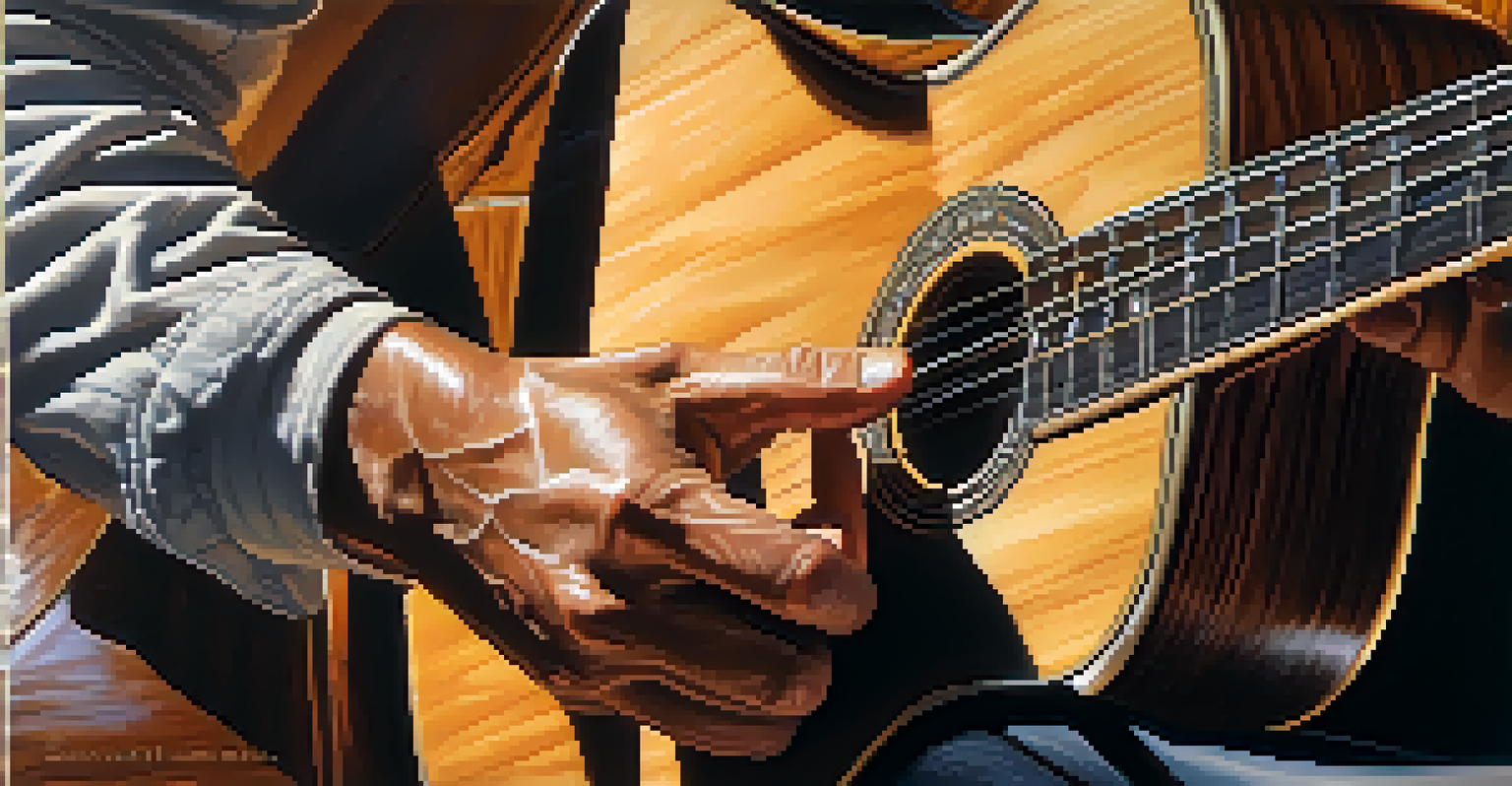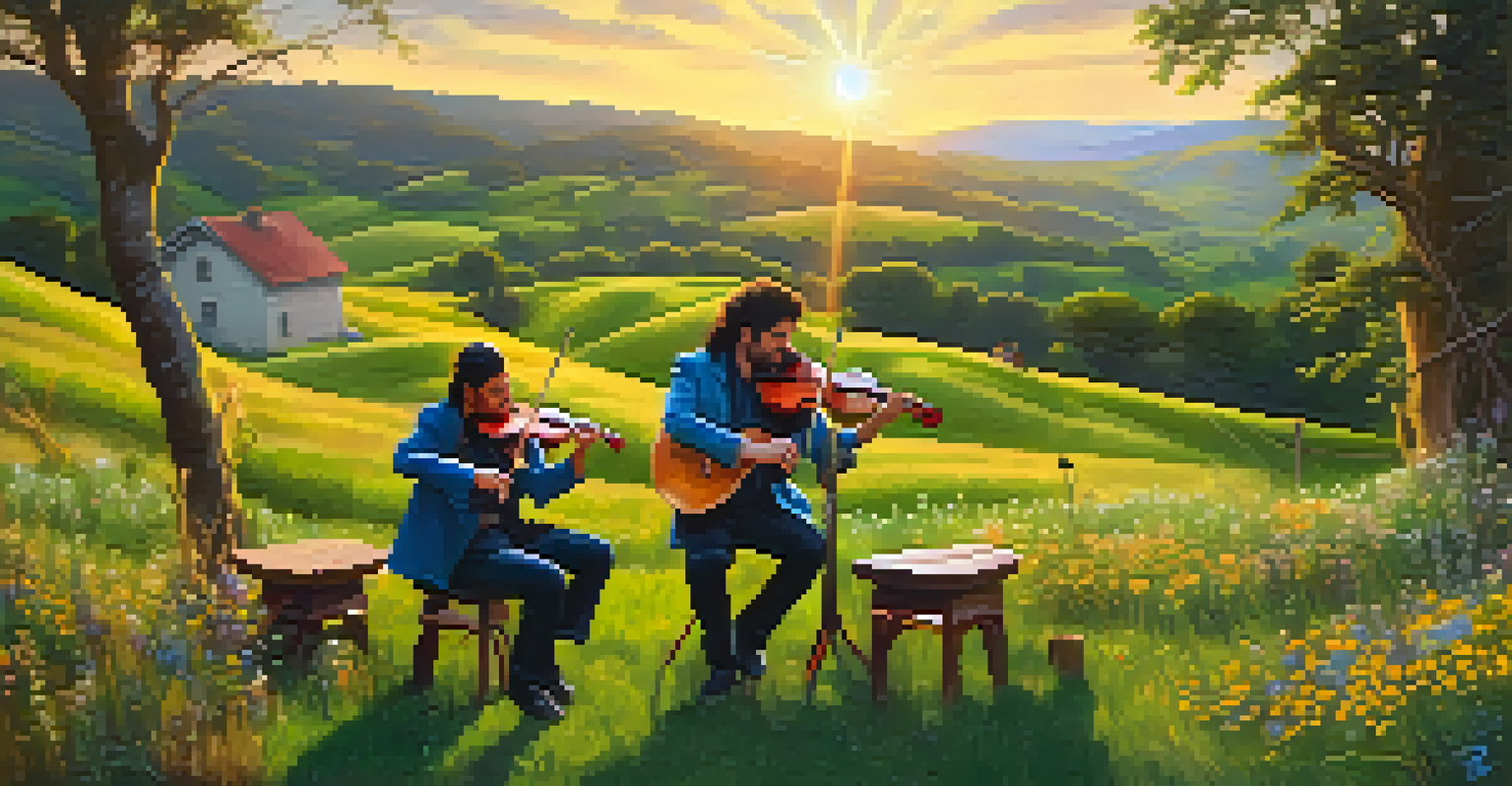Celtic Traditions: The Unique Styles of Irish Guitar Playing

The Roots of Irish Guitar: A Brief History
Irish guitar playing has deep roots in the Celtic tradition, blending various musical influences over centuries. The guitar, while not originally a traditional Irish instrument, gained prominence in the 20th century as musicians sought new ways to express their heritage. This shift allowed for a fusion of the old and new, creating a vibrant landscape for innovation.
Music can change the world because it can change people.
In the early days, instruments like the harp and fiddle dominated Irish music, but the guitar's versatility soon found its place. As folk music revitalized in the 1960s, guitarists began to incorporate traditional melodies, providing a fresh take on classic tunes. The guitar became a staple in sessions and performances, bridging gaps between generations.
Today, the Irish guitar scene is a tapestry of styles that reflect both historical influences and modern creativity. Players from various backgrounds contribute to its evolution, ensuring that the spirit of Celtic music continues to thrive. This rich history sets the stage for understanding the unique styles that characterize Irish guitar playing.
Traditional Fingerstyle Techniques in Irish Guitar
One of the hallmark techniques in Irish guitar playing is fingerstyle, which allows for intricate melodies and harmonies. This approach harkens back to traditional methods used by Celtic musicians, emphasizing the importance of individual expression. Fingerstyle playing brings a personal touch, enabling guitarists to convey emotion and storytelling through their music.

In contrast to strumming, fingerstyle involves plucking individual strings, creating a more nuanced sound. This technique often incorporates elements like hammer-ons and pull-offs, which add complexity and depth. For many players, mastering fingerstyle is a rite of passage, allowing them to connect more profoundly with their cultural roots.
Irish Guitar's Rich Historical Roots
Irish guitar playing has evolved by blending traditional Celtic influences with modern styles, creating a vibrant musical landscape.
Moreover, fingerstyle techniques often vary regionally, with players in different areas developing their own unique nuances. This results in a diverse array of sounds and styles, each telling its own story. As musicians explore these traditional techniques, they keep the essence of Irish music alive while also pushing creative boundaries.
The Role of Drones and Open Tunings
Drones and open tunings play a significant role in the distinctive sound of Irish guitar music. Drones, which involve playing a sustained note alongside melodies, create a rich harmonic backdrop that enhances the overall feel. This technique is reminiscent of traditional instruments like the bagpipe, adding a unique flavor to the guitar's sound.
The guitar is a small orchestra. It is polyphonic. Every guitar is a different color, a different sound.
Open tunings, where the guitar is tuned to a specific chord, allow for easier access to complex fingerings and vibrant chord voicings. Many Irish guitarists utilize these tunings to create lush, resonant soundscapes. This approach not only simplifies playing but also opens up new creative possibilities for composition and improvisation.
By combining drones with open tunings, guitarists can evoke the haunting beauty often associated with Irish music. This synergy invites listeners into a world of sonorous exploration, making each performance a captivating experience. The interplay of these elements showcases the guitar's adaptability within the rich tapestry of Celtic traditions.
Rhythmic Patterns: The Heartbeat of Irish Music
Rhythm serves as the heartbeat of Irish music, and guitarists often employ specific patterns to maintain the tempo of traditional tunes. These rhythmic structures are essential for keeping time in lively jigs and reels, ensuring that the music feels energetic and engaging. Just like a drummer, the guitarist plays a crucial role in setting the pace for other musicians.
Common rhythmic patterns include the use of triplets and syncopation, creating a lively bounce that encourages dancing. Guitarists often develop their own interpretations of these patterns, adding personal flair while respecting traditional forms. This dynamic interplay between rhythm and melody is what makes Irish music so captivating.
Importance of Collaboration in Music
The Irish guitar community thrives on collaboration, encouraging musicians of all backgrounds to come together and share their unique styles.
As guitarists gain proficiency in these rhythmic patterns, they enhance not only their playing but also the overall musical experience. The ability to lock in with other instruments fosters a sense of camaraderie and collective expression. This rhythmic foundation is a testament to the collaborative spirit that defines Irish music.
Modern Influences and Innovations in Irish Guitar
While steeped in tradition, Irish guitar playing is also influenced by modern musical styles and innovations. Contemporary artists often blend genres, incorporating elements from rock, folk, and even pop into their performances. This fusion creates a fresh sound that resonates with both traditionalists and new audiences alike.
Many guitarists experiment with effects pedals, looping, and other technology to enhance their sound. These tools allow for greater creativity and the ability to layer different musical elements, resulting in a rich sonic experience. This modern approach helps keep Irish music relevant, appealing to a wider audience while staying true to its roots.
By embracing modern influences, Irish guitarists are not only preserving their heritage but also pushing the boundaries of what is possible. This ongoing evolution ensures that Irish guitar music remains vibrant and exciting, inviting new generations to explore its depths. The blend of tradition and innovation is what makes this style so enduring and cherished.
Celtic Collaborations: The Community Aspect of Irish Music
Irish guitar playing thrives within a collaborative community, where musicians share ideas and techniques. Sessions in pubs and community centers often serve as the heart of this collaboration, bringing together players of all skill levels. These gatherings foster a sense of belonging and encourage the exchange of musical styles and traditions.
Collaboration often extends beyond just guitarists, with musicians from various backgrounds joining forces. This includes fiddlers, flutists, and singers, all contributing their unique perspectives. Such interactions enrich the musical landscape, allowing for diverse interpretations and new arrangements of traditional tunes.
Future of Irish Guitar is Bright
New generations are embracing and innovating Irish guitar music, ensuring its relevance and vitality in the modern musical world.
By participating in these communal experiences, guitarists not only hone their skills but also deepen their connection to Irish culture. The shared joy of making music creates lasting bonds among musicians, reinforcing the idea that Irish music is as much about community as it is about individual expression. This spirit of collaboration is vital in keeping the traditions alive.
The Future of Irish Guitar Playing: A Growing Tradition
As we look to the future, the tradition of Irish guitar playing continues to evolve and grow. New generations of musicians are discovering the joy of playing Irish music, often blending their influences with traditional styles. This ongoing exploration ensures that the art form remains vibrant and relevant in a rapidly changing world.
Educational opportunities, such as workshops and online tutorials, are making it easier for aspiring guitarists to learn the intricacies of Irish music. Access to resources and expert guidance allows newcomers to dive into the rich history and techniques with confidence. This influx of talent promises to bring fresh perspectives and innovations to the genre.

Ultimately, the future of Irish guitar playing lies in its ability to adapt while honoring its past. As musicians continue to experiment and collaborate, they will undoubtedly carry forward the traditions that have shaped this beautiful art form. The journey of Irish guitar playing is far from over, and its legacy will continue to inspire and captivate audiences around the world.